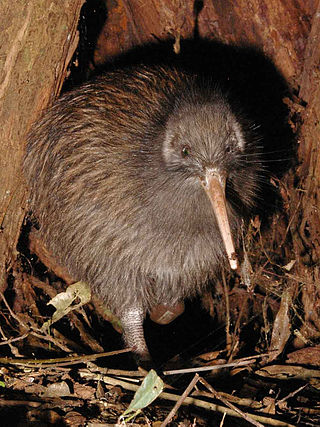
Kiwi are flightless birds endemic to New Zealand of the order Apterygiformes. The five extant species fall into the family Apterygidae and genus Apteryx. Approximately the size of a domestic chicken, kiwi are the smallest living ratites.
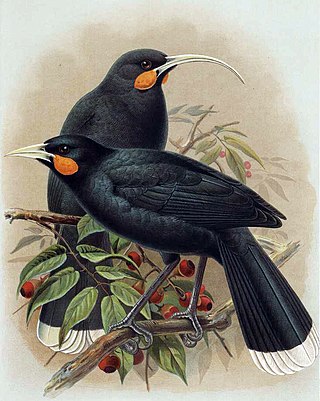
The huia is an extinct species of New Zealand wattlebird, endemic to the North Island of New Zealand. The last confirmed sighting of a huia was in 1907, although there was a credible sighting in 1924.
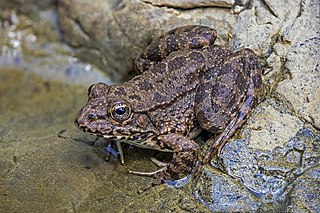
True frogs is the common name for the frog family Ranidae. They have the widest distribution of any frog family. They are abundant throughout most of the world, occurring on all continents except Antarctica. The true frogs are present in North America, northern South America, Europe, Africa, and Asia. The Asian range extends across the East Indies to New Guinea and a single species, the Australian wood frog, has spread into the far north of Australia.
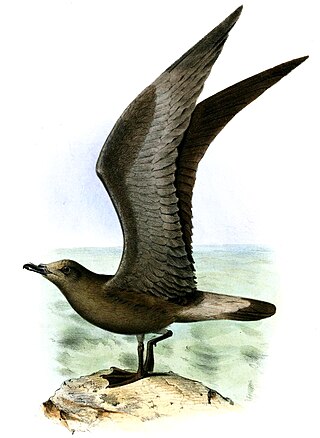
The Jamaican petrel is a small possibly extinct seabird in the gadfly petrel genus, Pterodroma. It is related to the black-capped petrel.

The Guadalupe caracara or mourning caracara is an extinct bird of prey belonging to the falcon family (Falconidae). It was, together with the closely related crested caracara, formerly placed in the genus Polyborus. It was also known as the quelili or the calalie.

The New Zealand merganser, also known as Auckland merganser or Auckland Islands merganser, was a typical merganser which is now extinct.

Coextinction and cothreatened refer to the phenomena of the loss or decline of a host species resulting in the loss or endangerment of an other species that depends on it, potentially leading to cascading effects across trophic levels. The term originated by the authors Stork and Lyal (1993) and was originally used to explain the extinction of parasitic insects following the loss of their specific hosts. The term is now used to describe the loss of any interacting species, including competition with their counterpart, and specialist herbivores with their food source. Coextinction is especially common when a keystone species goes extinct.

The laughing owl, also known as whēkau or the white-faced owl, was an endemic owl of New Zealand. Plentiful when European settlers arrived in New Zealand, its scientific description was published in 1845, but it was largely or completely extinct by 1914. The species was traditionally considered to belong to the monotypic genus SceloglauxKaup, 1848, although recent genetic studies indicate that it belongs with the boobook owls in the genus Ninox.

The South Island piopio also known as the New Zealand thrush, was a passerine bird of the family Oriolidae.
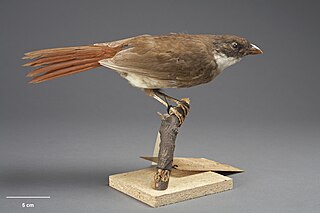
The North Island piopio was a passerine bird of the family Oriolidae. The North Island piopio is now considered to be extinct.

The Guadalupe storm petrel is a small seabird of the storm petrel family Hydrobatidae. It has been assessed as Critically Endangered or possibly extinct.

The New Caledonian rail is a large and drab flightless rail that is found on the island of New Caledonia in the Pacific. It is a dull brown above, with grey underparts, and has a yellowish, downward-curving bill. No one knows what it sounds like and it is not known whether it is nocturnal or crepuscular.
Hodgens' waterhen is an extinct rail species from New Zealand. Its name commemorates the Hodgen brothers who were owners of the Pyramid Valley swamp where the holotype was discovered. It reached a weight of 280 g and its wings were so reduced that it was unable to fly. It occupied a wide range of habitats, including open forest and grassland along riverbanks.
Hastings Boys' High School is a boys' secondary school in Hastings, New Zealand. The school is part of the Super 8. The school was founded in 1904 as Hastings High School. In 1922, it became Hastings Technical School under the leadership of William Penlington, who remained headmaster until 1949.
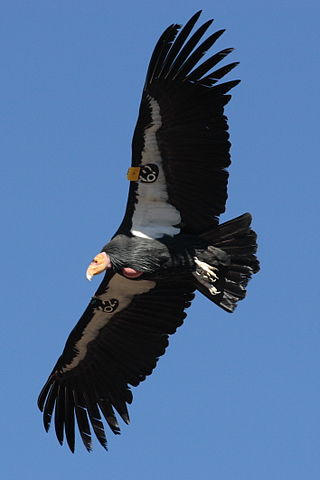
A large proportion of living species on Earth live a parasitic way of life. Parasites have traditionally been seen as targets of eradication efforts, and they have often been overlooked in conservation efforts. In the case of parasites living in the wild – and thus harmless to humans and domesticated animals – this view is changing.
Columbicola extinctus, also known as the passenger pigeon chewing louse, is an extant species of phtilopterid louse that was once believed to have been extinct with its only known host, the passenger pigeon, prior to its rediscovery living on band-tailed pigeons. Like other members of the genus Columbicola, the insect is a long, slender louse that shows marked sexual dimorphism in the antennae, as the male's are much longer than those of the female in the third segment. It is between 2.15 and 2.47 mm long overall. The male's head is between 0.52 and 0.59 mm long and broadens to form a slight shoulder at the anterior plate. The female's head is slightly larger at 0.53 to 0.64 mm. The thorax has two very long setae on each side. The generic name Columbicola comes from the Latin words columba, "dove," and -cola, "inhabitant," in reference to the genus's primary hosts.

Rallicola is a genus of chewing louse. It is an ectoparasite of rails and other birds. It was named by Thomas Harvey Johnston and Launcelot Harrison in 1911. There are two subgenera aside from the nominotypical subgenus: Aptericola, whose species are found on kiwi birds, and Huiacola, a monospecific subgenus consisting of Rallicola extinctus, once found on the huia.

Apterygon is a genus of louse. It is endemic to New Zealand and is an ectoparasite of kiwi birds (Apteryx). Theresa Clay circumscribed the genus in 1961. In 1947, she had referred to this genus as "New Genus D", but it was not formally named as she needed to confirm the host of her specimen as well as additional material.
Muriwaimanu is an extinct genus of early penguin.
Hierodoris huia is a species of moth in the family Oecophoridae. It is endemic to New Zealand. It is only known from two sites in Titirangi that are approximately 1 to 2 km apart. H. huia is suspected to be a forest canopy-dweller. This species is on the wing in January. Although the adult moths are attracted to light it has been hypothesised that it is a diurnal species on the basis of the behaviour the species exhibit when light trapped. The species was named in honour of the extinct bird species, the huia, as well as the type locality of Huia Road, Titirangi. This species is classified as "Data Deficient" by the Department of Conservation.














